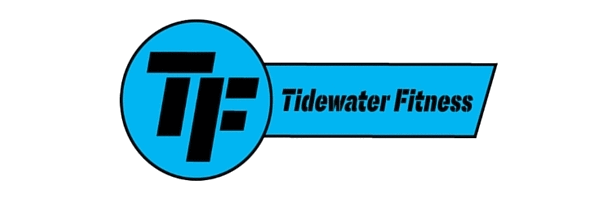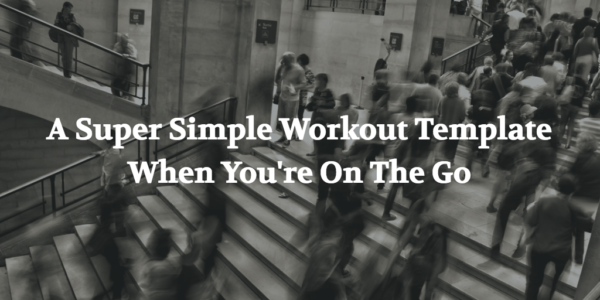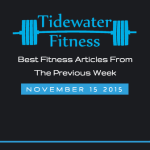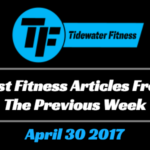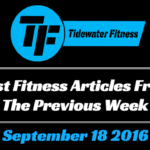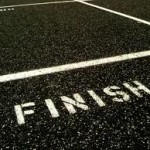We live in a busy world.
My wife, Candice, and I were in New York City a couple of months ago. I’d been there five years ago, but didn’t remember too much about the trip (other than the tourist attractions of course).
One thing that stuck out to me, this time around, was all the people in the subway station. We were trying to catch a train to Times Square our first night and there were people everywhere walking as fast as they could to get to their next stop. It looked like ants in an ant hill.
No one said a word to another person. They were focused on getting to their destination without any interruption. There was no time to do anything else.
This is the norm in our society today.
We all have jobs, families, and social lives that we devote time to each day. This leaves little room for other activities, especially anything fitness related.
But the one saying I’m reminded of is “something is always better than nothing”. And this is true of working out.
Many do not want to go to the gym because it takes up too much time out of their day. You may be traveling, have a big deadline at work, or have to pick your kids up from soccer practice.
But the good news is you don’t need to spend two hours in the gym to see the benefits of working out. You just need a more appropriate plan to suit your needs and time constraints.
I think most would agree they go to the gym because they want look better and feel better. And if this sounds like you, strength training will play a vital role in you obtaining these goals. Having said that, I want to provide you with a super simple workout template when you’re on the go.
The main idea behind this template is to give you a great workout that hits multiple major muscle groups in a short amount of time. Here it is:
1A) Core
1B) Lower Body Push or Lower Body Pull
2A) Upper Body Horizontal Push or Upper Body Vertical Push
2B) Upper Body Horizontal Pull or Upper Body Vertical Pull
Let’s elaborate this.
In a previous article, I mentioned how a total body workout hits five major areas of the body. These include:
– The front of the upper body (chest/shoulders)
– The back of the upper body (upper back/shoulders)
– The core
– The front of the lower body (quads)
– The back of the lower body (glutes/hamstrings)
This isn’t the entire body, obviously, but it includes many of the big, major muscle groups of the body. That was the standard in setting up this template. You’ll notice, though, there is only one lower body exercise. The reason for this is to get you in and out of the gym as fast as possible.
Now, let’s break down each category.
1A
The first exercise you’ll do is a core exercise. Core training often consists of exercises like sit ups and crunches, but this isn’t how you properly train your abs.
You can select any exercise you want in this category, but it should be centered around movements like loaded carries and those that work to resist flexion, extension, and rotation of the spine.
Things like Farmer’s carries, Deadbugs, Planks, Side bridges, and Pallof presses work well here.
1B
The second exercise is the lower body exercise. In this category, you’ll see lower body push or lower body pull. This simply refers to the type of lower body exercise you’re doing.
Lower body push exercises work the quads. Things like Squats, Step ups, and Lunges. Lower body pull exercises work the glutes and hamstrings. Think Deadlifts, Romanian deadlifts, and Hip thrusts.
Since there’s only one lower body exercise, you can select either type you’d like. I’d recommend alternating push and pull exercises. So if you did squats one day, you’d do deadlifts the second day.
2A
Next on the list is either an upper body horizontal push or vertical push. Just like above, these refer to the type of upper body exercise you’re doing.
An upper body horizontal push is any movement where you’re pressing directly away from you in a horizontal fashion. Think Dumbbell bench presses, Cable chest presses, or Push ups. A vertical press, on the other hand, is any exercise where you’re pressing overhead. Some examples include the Dumbbell overhead press, Barbell overhead press, and Dumbbell push press.
Just like the lower body recommendation, I’d rotate between each type of movement. If you do a horizontal press on the first workout of the week then do a vertical press on the second.
2B
And lastly, we have the upper body horizontal pull or vertical pull. These categories are exactly like the press, except they work the upper back instead of the chest.
An upper body horizontal pull includes any movement where you’re pulling with your arms horizontally out in front on you. Exercises like Dumbbells bench rows, Seated rows, and Batwing rows all fit the bill. A vertical pull includes exercises where you’re pulling with your arms overhead. Chin ups, Pull Ups, and Lat pull downs would all be considered vertical pulls.
Again, rotate between horizontal and vertical pulls with each workout you do.
Now that you know what type of exercises you’ll be doing, let’s talk briefly about exercise order, sets, reps, and rest.
The first thing you’ll notice is the number and letter attached to each exercise. This is the order, in which, you’ll perform the exercises. 1a and 1b will be paired together in a superset. You’ll complete one set of 1a and then one set of 1b. You’ll alternate like this until you complete the allotted sets and reps. Then you’ll do the same with 2A and 2B.
As far as sets go, aim for three in each exercise. If you have enough time, knock out four. Base it on your schedule. With reps, anything in the 6-12 rep range will work well. The easiest thing to do is select a rep range like 6-8 or 10-12. Work with a weight that’s manageable for this range. Once you complete each set with the highest number of reps (8 reps in the 6-8 range or 12 in the 10-12 range), increase the weight.
Finally, rest should be in the 30-60 second range. An easy way to think about this is low reps-high rest and high reps-low rest. If you’re using a lower rep scheme (6-8), you’ll need more rest time (45-60 seconds). And vice versa if you’re using a higher rep range.
Conclusion
We’re all busy. There’s no getting around that. But remember, something is always better than nothing.
If you want to look better and feel better, you need to be in the gym. But what you don’t need is to spend countless hours doing useless exercises.
If you’re on the go, use this template as a guide to get an efficient workout with minimal time. It will help you successfully juggle life, family, and fitness so nothing gets put on the back burner.
